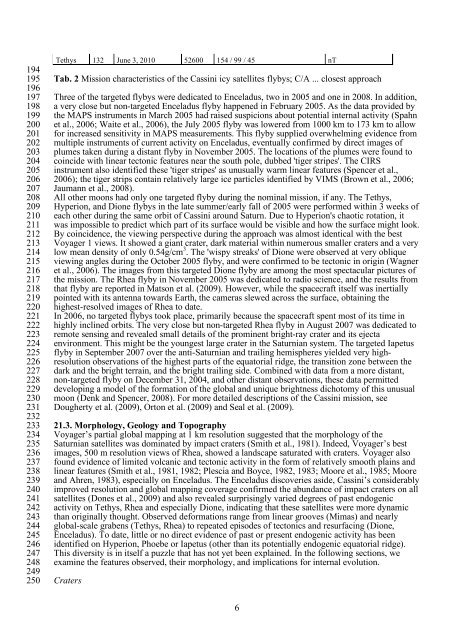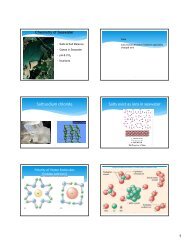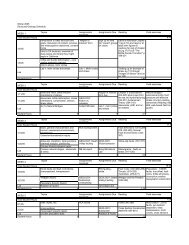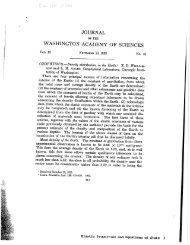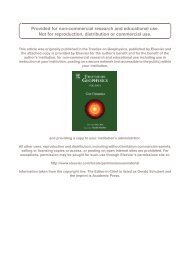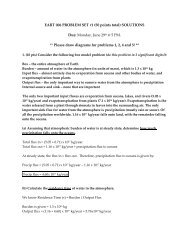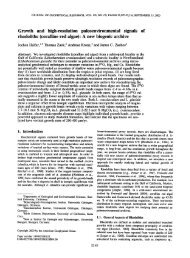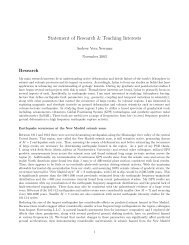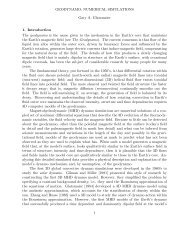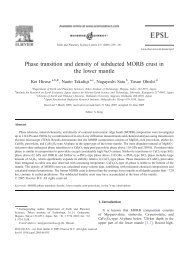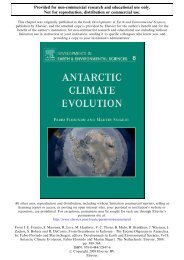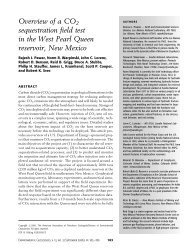Reprint - Earth & Planetary Sciences - University of California, Santa ...
Reprint - Earth & Planetary Sciences - University of California, Santa ...
Reprint - Earth & Planetary Sciences - University of California, Santa ...
You also want an ePaper? Increase the reach of your titles
YUMPU automatically turns print PDFs into web optimized ePapers that Google loves.
Tethys 132 June 3, 2010 52600 154 / 99 / 45 nT<br />
194<br />
195<br />
196<br />
Tab. 2 Mission characteristics <strong>of</strong> the Cassini icy satellites flybys; C/A ... closest approach<br />
197 Three <strong>of</strong> the targeted flybys were dedicated to Enceladus, two in 2005 and one in 2008. In addition,<br />
198 a very close but non-targeted Enceladus flyby happened in February 2005. As the data provided by<br />
199 the MAPS instruments in March 2005 had raised suspicions about potential internal activity (Spahn<br />
200 et al., 2006; Waite et al., 2006), the July 2005 flyby was lowered from 1000 km to 173 km to allow<br />
201 for increased sensitivity in MAPS measurements. This flyby supplied overwhelming evidence from<br />
202 multiple instruments <strong>of</strong> current activity on Enceladus, eventually confirmed by direct images <strong>of</strong><br />
203 plumes taken during a distant flyby in November 2005. The locations <strong>of</strong> the plumes were found to<br />
204 coincide with linear tectonic features near the south pole, dubbed 'tiger stripes'. The CIRS<br />
205 instrument also identified these 'tiger stripes' as unusually warm linear features (Spencer et al.,<br />
206 2006); the tiger strips contain relatively large ice particles identified by VIMS (Brown et al., 2006;<br />
207<br />
208<br />
Jaumann et al., 2008).<br />
All other moons had only one targeted flyby during the nominal mission, if any. The Tethys,<br />
209 Hyperion, and Dione flybys in the late summer/early fall <strong>of</strong> 2005 were performed within 3 weeks <strong>of</strong><br />
210 each other during the same orbit <strong>of</strong> Cassini around Saturn. Due to Hyperion's chaotic rotation, it<br />
211 was impossible to predict which part <strong>of</strong> its surface would be visible and how the surface might look.<br />
212 By coincidence, the viewing perspective during the approach was almost identical with the best<br />
213 Voyager 1 views. It showed a giant crater, dark material within numerous smaller craters and a very<br />
low mean density <strong>of</strong> only 0.54g/cm 3 214<br />
. The 'wispy streaks' <strong>of</strong> Dione were observed at very oblique<br />
215 viewing angles during the October 2005 flyby, and were confirmed to be tectonic in origin (Wagner<br />
216 et al., 2006). The images from this targeted Dione flyby are among the most spectacular pictures <strong>of</strong><br />
217 the mission. The Rhea flyby in November 2005 was dedicated to radio science, and the results from<br />
218 that flyby are reported in Matson et al. (2009). However, while the spacecraft itself was inertially<br />
219 pointed with its antenna towards <strong>Earth</strong>, the cameras slewed across the surface, obtaining the<br />
220 highest-resolved images <strong>of</strong> Rhea to date.<br />
221 In 2006, no targeted flybys took place, primarily because the spacecraft spent most <strong>of</strong> its time in<br />
222 highly inclined orbits. The very close but non-targeted Rhea flyby in August 2007 was dedicated to<br />
223 remote sensing and revealed small details <strong>of</strong> the prominent bright-ray crater and its ejecta<br />
224 environment. This might be the youngest large crater in the Saturnian system. The targeted Iapetus<br />
225 flyby in September 2007 over the anti-Saturnian and trailing hemispheres yielded very high-<br />
226 resolution observations <strong>of</strong> the highest parts <strong>of</strong> the equatorial ridge, the transition zone between the<br />
227 dark and the bright terrain, and the bright trailing side. Combined with data from a more distant,<br />
228 non-targeted flyby on December 31, 2004, and other distant observations, these data permitted<br />
229 developing a model <strong>of</strong> the formation <strong>of</strong> the global and unique brightness dichotomy <strong>of</strong> this unusual<br />
230 moon (Denk and Spencer, 2008). For more detailed descriptions <strong>of</strong> the Cassini mission, see<br />
231<br />
232<br />
Dougherty et al. (2009), Orton et al. (2009) and Seal et al. (2009).<br />
233 21.3. Morphology, Geology and Topography<br />
234 Voyager’s partial global mapping at 1 km resolution suggested that the morphology <strong>of</strong> the<br />
235 Saturnian satellites was dominated by impact craters (Smith et al., 1981). Indeed, Voyager’s best<br />
236<br />
237<br />
images, 500 m resolution views <strong>of</strong> Rhea, showed a landscape saturated with craters. Voyager also<br />
found evidence <strong>of</strong> limited volcanic and tectonic activity in the form <strong>of</strong> relatively smooth plains and<br />
238 linear features (Smith et al., 1981, 1982; Plescia and Boyce, 1982, 1983; Moore et al., 1985; Moore<br />
239 and Ahren, 1983), especially on Enceladus. The Enceladus discoveries aside, Cassini’s considerably<br />
240 improved resolution and global mapping coverage confirmed the abundance <strong>of</strong> impact craters on all<br />
241 satellites (Dones et al., 2009) and also revealed surprisingly varied degrees <strong>of</strong> past endogenic<br />
242 activity on Tethys, Rhea and especially Dione, indicating that these satellites were more dynamic<br />
243 than originally thought. Observed deformations range from linear grooves (Mimas) and nearly<br />
244 global-scale grabens (Tethys, Rhea) to repeated episodes <strong>of</strong> tectonics and resurfacing (Dione,<br />
245<br />
246<br />
Enceladus). To date, little or no direct evidence <strong>of</strong> past or present endogenic activity has been<br />
identified on Hyperion, Phoebe or Iapetus (other than its potentially endogenic equatorial ridge).<br />
247 This diversity is in itself a puzzle that has not yet been explained. In the following sections, we<br />
248<br />
249<br />
examine the features observed, their morphology, and implications for internal evolution.<br />
250<br />
Craters<br />
6


